When Pep Guardiola goes out of his way to compliment you for your success and football philosophy, you must be doing something right.
That’s where we find Marcelo Gallardo, the former Argentinian attacking midfielder who recently won his first Argentine Primera División with River Plate. They not only won the league, but they outperformed their competition in virtually every significant metric, especially on the attacking side of the ball.
Gallardo’s tactics make him one of the most desirable managers in the game. Winning three consecutive South American Coach of the Year Awards (2018-2020) only helps his case. Though he has renewed his contract with River Plate for the 2022 season, there is, of course, speculation that he will make the move to one of Europe’s elite clubs in the near future. After all, if you’re catching the eye of the Manchester City manager, there’s a sense that you’re contributing to the tactical innovations at the forefront of the game. The links to Uruguay and to clubs like Barcelona, prior to Xavi taking the managerial reins, gives the sense of the quality and style of play he brings to his clubs. That innovation positions him perfectly for the next step in his career.
This coaching analysis will show why Gallardo is in such demand. We’ll first look at the data underlying the 2021 season at River Plate. With a statistical understanding of how his team plays, we will have a look at the side’s attacking tactics, particularly in the way Gallardo uses overloads to create goalscoring opportunities. Finally, his side is a very aggressive pressing team. Between the high press and counterpress, we want to give you a sense of his team’s identity. His philosophy is well equipped for the upper echelons of the game and this analysis will give a sense of Gallardo’s philosophy and the bright future ahead of him.
Running the data
Data is always a great place to start. Scanning through the Primera División statistics, one very clear thing was the degree of separation between River Plate and the rest of the league. They won the league, but the statistics show just how comfortable they were. Evaluating the season performance from a statistical basis, Gallardo has developed a dynamic squad with an exciting brand.
Looking specifically at xG and xGA, we can immediately see that River Plate was in a league of their own. Estudiantes and Boca Juniors had very strong expected statistics as well, but you can see that one skews more heavily to the attack and the other to defence. River Plate had it all.
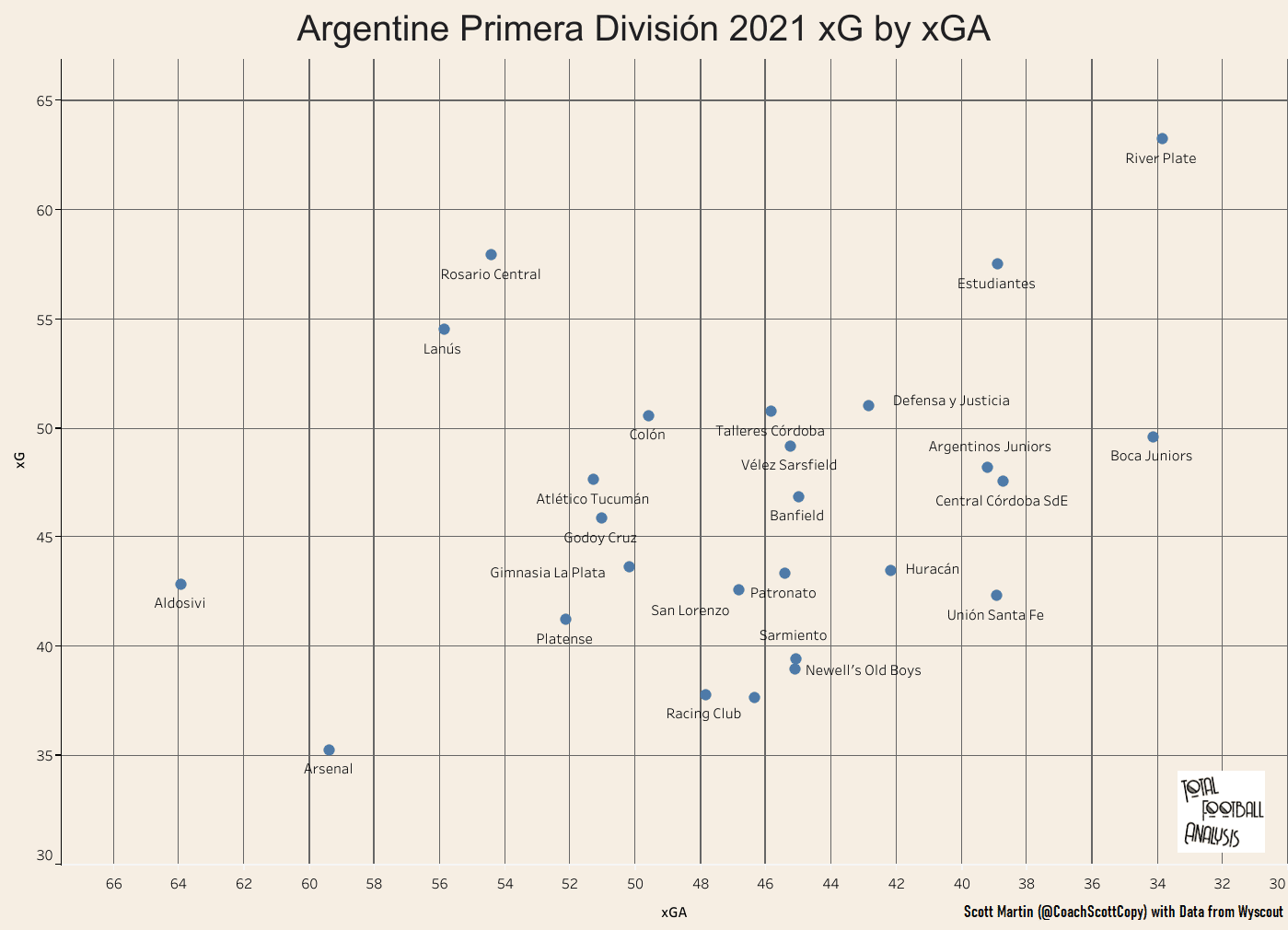
A dynamic attack with a stingy defence, they managed to lead the league in both xG and xGA. It was a total performance masterminded by an exciting young coach.
So, what made them so exciting? As you’ll see later in this tactical analysis, River Plate possessed an incredible blend of individual quality and scintillating team cohesion. Once again, we find that they’re the league leaders in our next two statistical categories: progressive runs and progressive passes. Though the progressive runs category was a slim margin of victory, they absolutely blew away the rest of the league with their progressive passes P90.
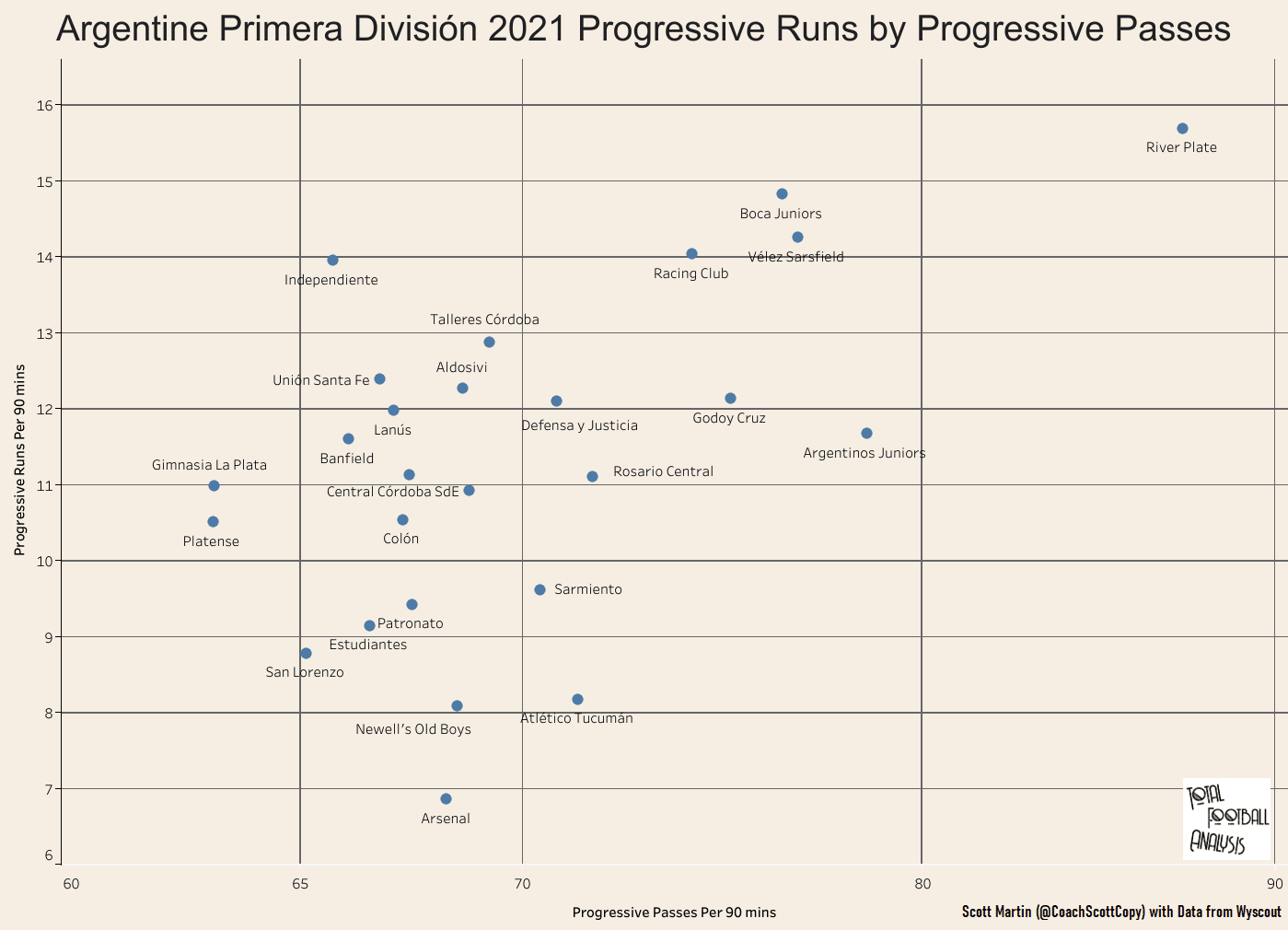
That explosive combination of individual talent and free-flowing, teamwide football presented a unique dilemma for their foes. Opponents struggled to take the ball off of River Plate. Maintaining some semblance of the defensive shape while applying pressure on the ball was often too much to ask. Overloads to create isolation in other areas of the pitch simply overwhelmed the competition.
Progression came easily for River Plate, positioning them to make highly effective moves into the final third. The first four statistical categories showed us anything from a narrow category win to something far more substantial. These last two categories, deep completions and key passes, are without a doubt the best representation we have of River Plate’s season through a stats analysis. They’re so clearly in a league of their own that it was difficult to fit each team’s name into the cluster on the bottom left corner. River Plate was so dominant, that they’re not only the only team in the top right quadrant, but virtually every other team in the league is in the bottom left, noting underperformance. Now that’s clearly not the case since the entire league can’t underperform, but what it does signify is River Plate’s dominance over the course of the season.
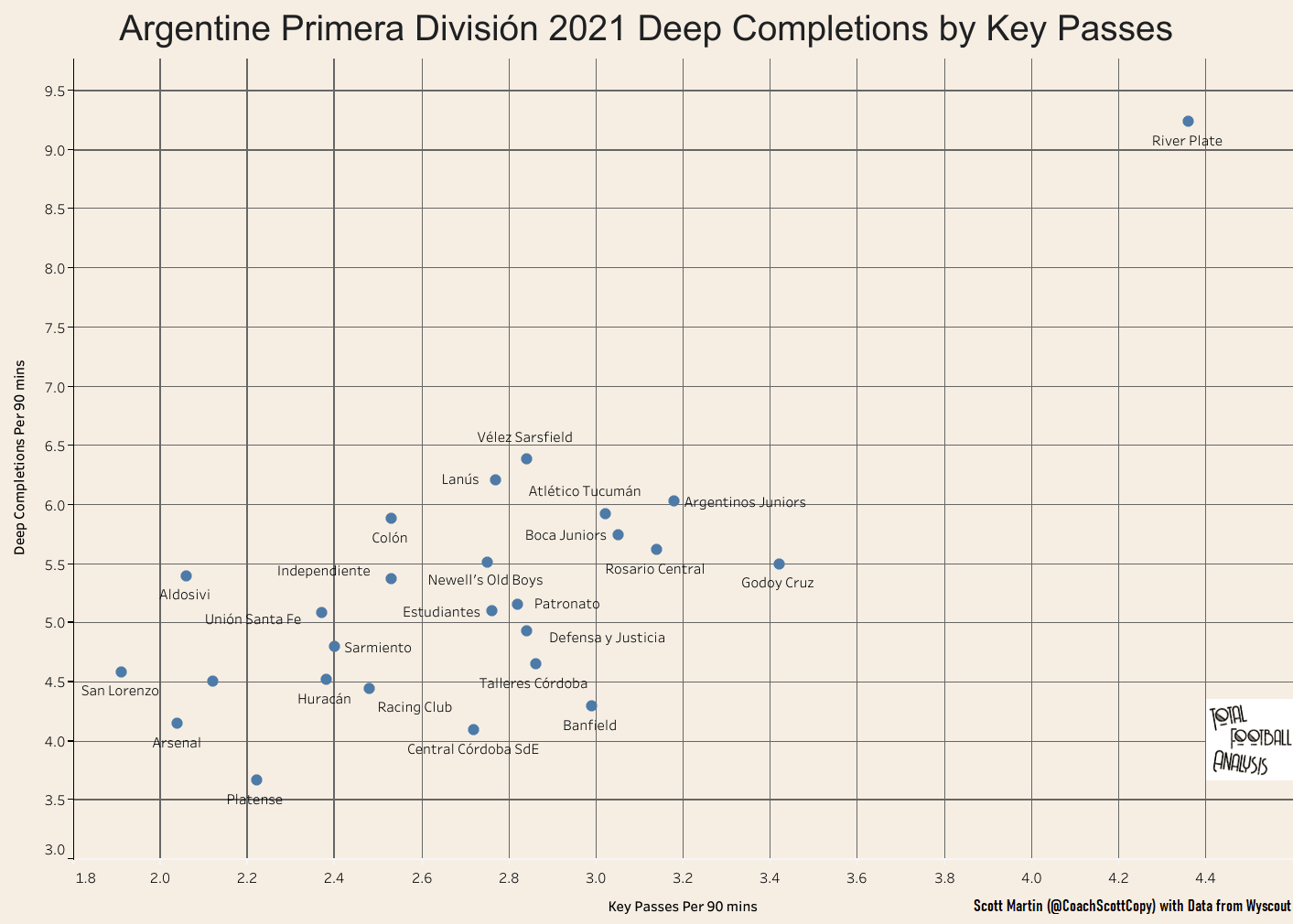
Perhaps what’s more impressive is that they managed this level of dominance with a variety of systems. You’ll often see top teams rely more heavily on one specific system than another. They’re more worried about themselves and optimizing their style of play rather than adapting to the quality and system of the opponents.
But not Gallardo’s River Plate. While he tended to favour a four-back system, he did use three back formations over the course of the season too. The midfield might have a traditional set of three, maybe utilise a diamond or even use three midfielders in slightly deeper roles to create a 2-3-5 or 3-2-5 in possession. Up top, we see something very similar. At times, there were three forwards and at other times, two forwards with a classic number 10 underneath.
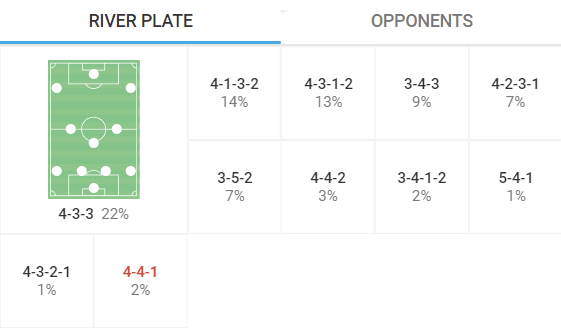
Between the systems Gallardo used and the significant statistical imbalances shown in this section, you get the sense that he’s a tactical mastermind, always finding little ways to throw his opponents off balance and create a growing sense of uncertainty in both the build-up to the game and the match itself.
Overloads in possession
Time to unpack River Plate’s dynamic attacking tactics. Rather than give a full breakdown through the phases, we’ll streamline the section to focus on key patterns and superiorities they tended to create higher up the pitch.
Watching their film, one immediately clear thing was the way in which Gallardo situates his numbers across the pitch. In most matches, a 2-3-5 or 3-2-5 attacking shape is apparent. The outside-backs provide the width, pushing high up the pitch in line with the three forwards, or two forwards and the number 10. Meanwhile, the three midfielders will often span the pitch from half-space to half-space. If they give a three at the back look, it’s the #6 who will drop in to provide the additional number.
Depending on the opposition, those three midfielders might play a little bit flatter in midfield, especially in the early attacking phases of play. As play progresses, the mids will look to push higher in support of the three central players in front of them. In the end, though, they want to find that balance of overloads near the ball while maintaining pitch control.
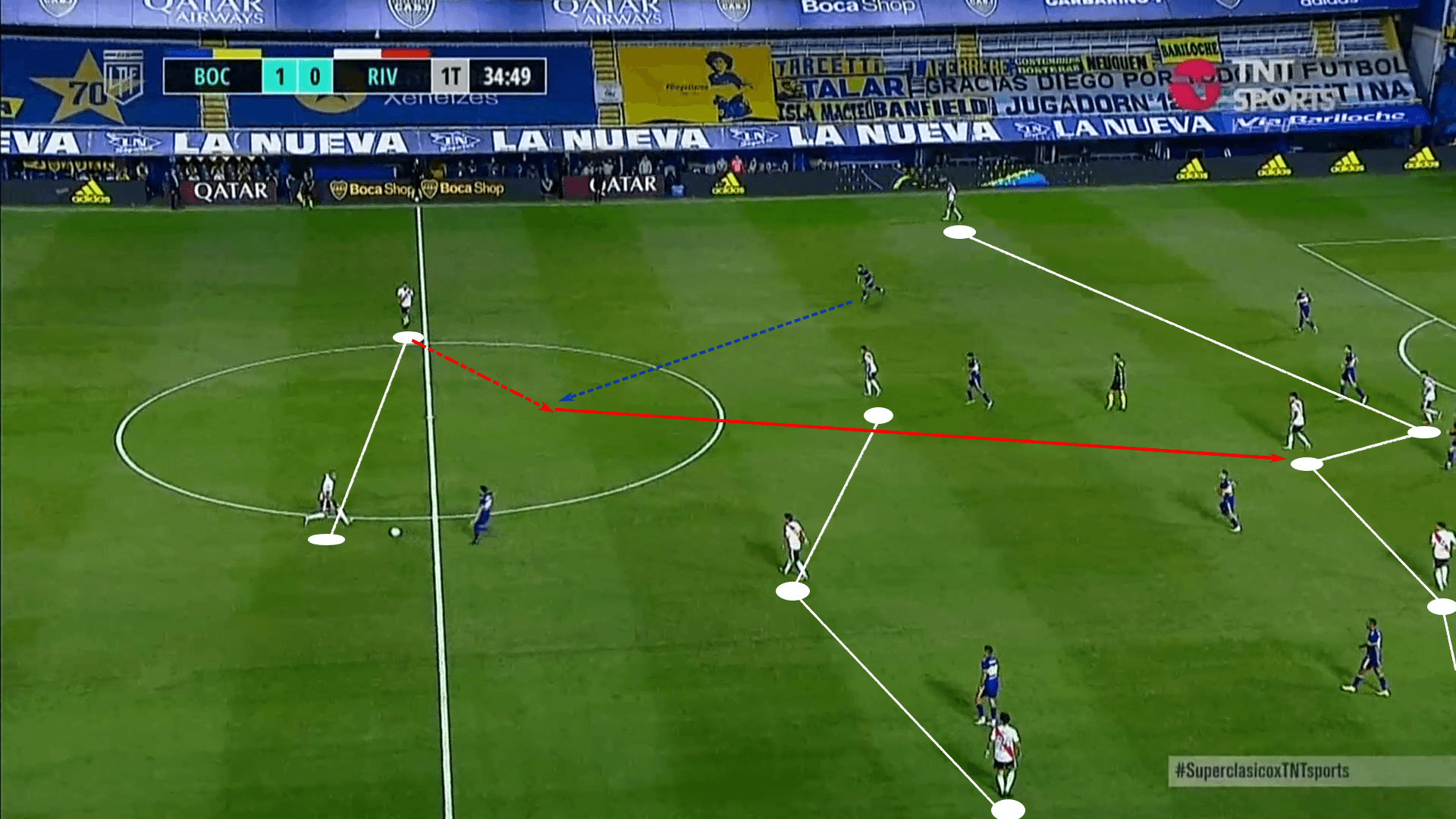
For example, against their arch-nemesis, Boca Junior, the 2-3-5 attacking shape was intact as the team looked to recycle possession through the centre-backs. Héctor Martínez attacked space with his first couple of touches, drawing the Boca Juniors midfield higher up the pitch. As the midfield stepped higher, the space between the lines grew, creating the opportunity for a line-breaking pass into the high central overload.
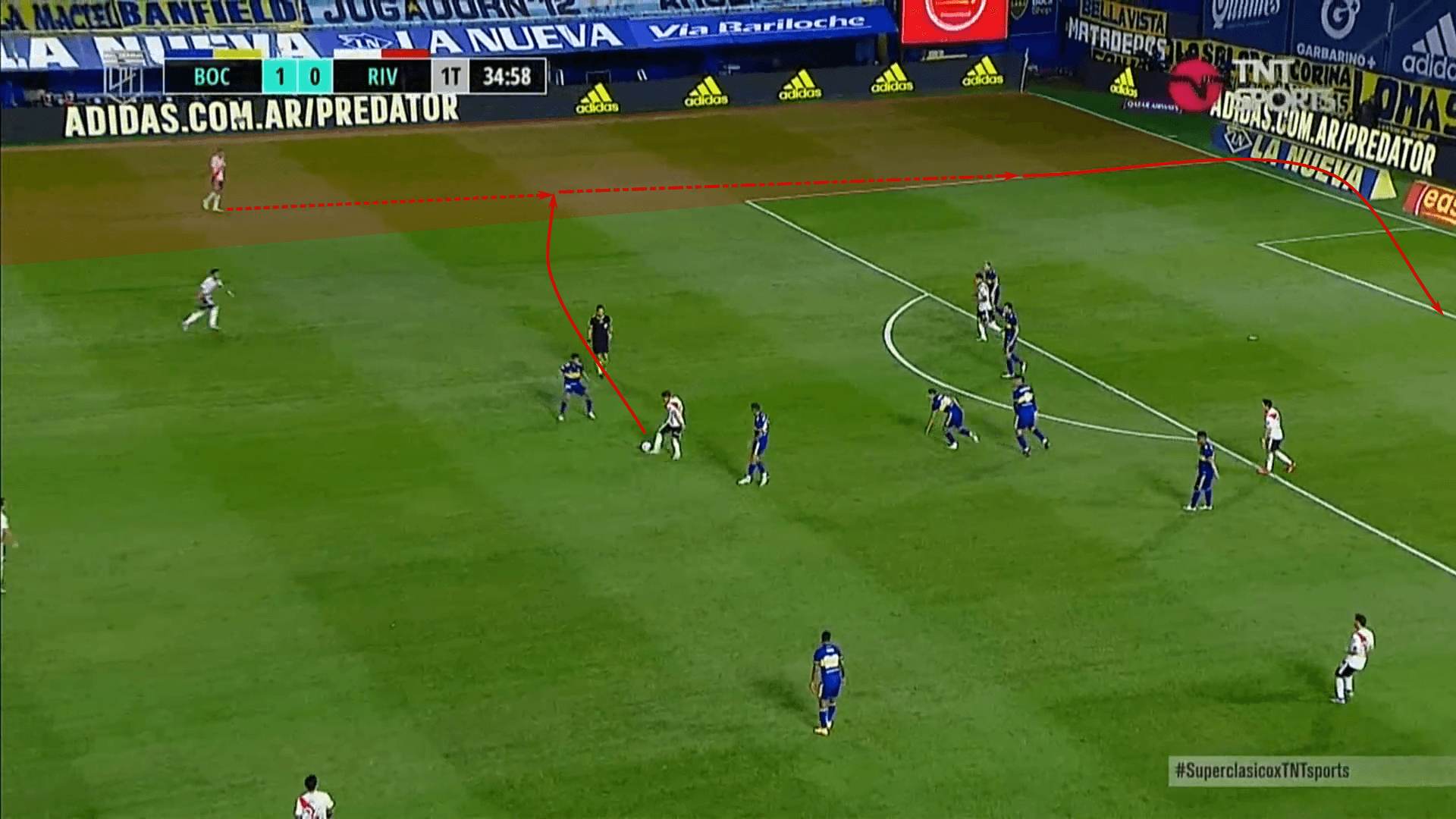
River Plate used an in-out-in pattern, sending the ball into the left-wing to Fabrizio Angileri, who carried the ball into the half-space of the box and sent a far-post cross that eluded his teammates.
The most striking aspect of Gallardo’s River Plate is how they used overloads in possession. Much like we see with the game’s top ideologues, like Guardiola and Liverpool’s Jürgen Klopp, Gallardo sets out to dominate the middle of the pitch. As possession-dominant as his sides are, he wants to immediately reduce the risk of opposition counterattacks by keeping numbers around the ball in possession. The attacking benefit is that his team creates numerical superiorities that force a response from the opposition. They can’t afford to sit back and let River Plate pick them apart. They must commit numbers towards the ball to stifle the attack.
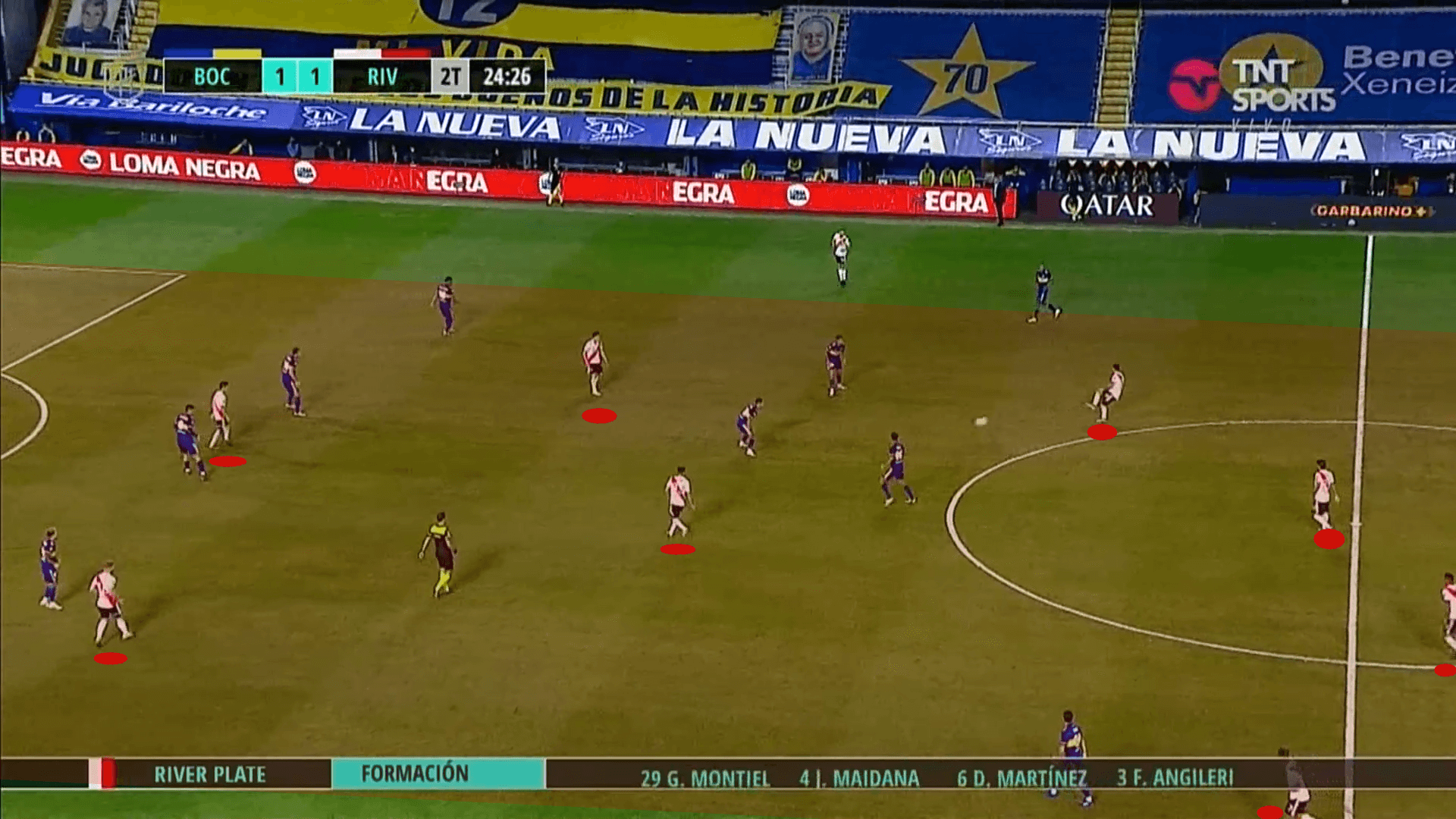
Again looking at their match against Boca Juniors, we get a clear picture of how horizontally compact the team is. There are two width providers on each side, then the remaining eight field players are very tightly connected from half-space to half-space. Looking at the numbers in the shaded area, River Plate is hardly even using the half-spaces.
Los Millonarios was very patient in possession, not looking for those progressive actions until they saw the right cues in the opposition’s defensive shape. Ball-near imbalances, significant spaces between the lines and leaving the River Plate outside-backs alone in the wings were just a few of the things they looked for in possession. Once those cues were in place, the team moved on to the next phase of the attack.
They offer a unique blend of patience in possession, intelligently searching for cues that signal the timing of progression coupled with a desire to break lines early. They’re unpredictable, at least in the flow of the match. A deeper analysis shows that the side ruthlessly takes the line-breaking passing options opponents give them. To strike that balance between patient possession and completing progressive passes, they have to be remarkably efficient with their movement off the ball, especially in supporting the first attacker and offering outlets between the lines. Gallardo’s River Plate looks very well connected throughout the match, allowing them to not only retain possession but to be dangerous with it as well.
They were remarkably efficient in progressing through the pitch, especially when using the wings. Again, that central overload did its part by unbalancing the opposition near the ball. With the opposition’s press disjointed, River Plate then had better access to their outside-backs. Oftentimes, the River Plate outside-backs had space to pick up as much as 20 or 30 yards on the dribble.
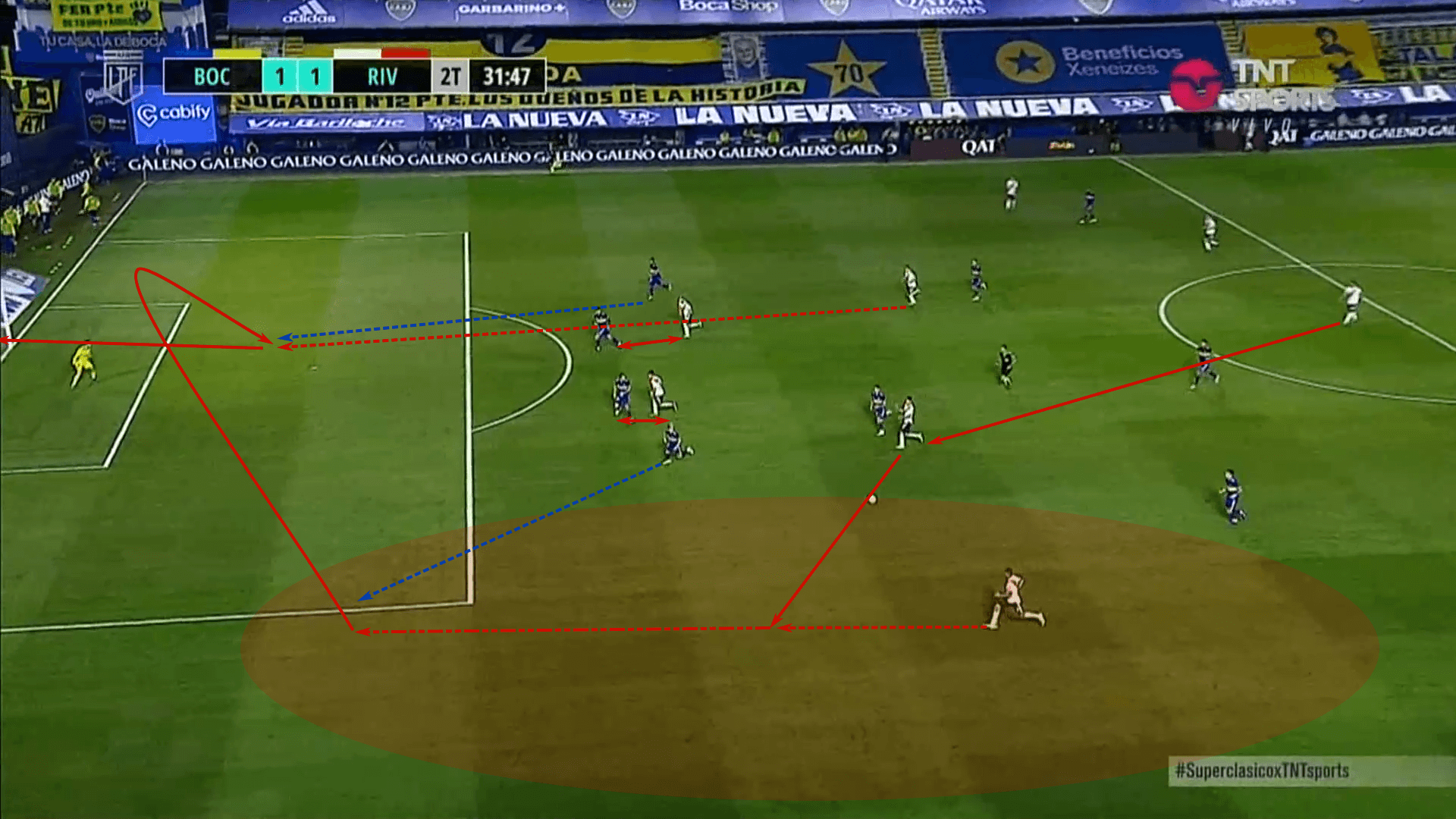
With opponents forced into horizontally compact defensive shapes to keep River Plate from picking them apart centrally, coverage on the wings was often sacrificed. That’s exactly what happened for the second goal against Boca Juniors. River Plate did well to find a line-breaking pass from the centreback to the #10, who played one more pass to get the ball into the left-wing. That forced Boca Juniors to send a member of their back four out wide to defend the cross. Initially, the home side enjoyed a 3v2 numeric advantage in the box. However, Julián Álvarez’s run from deep gave La Banda a 3v3 in the box. He cut inside of his mark and capitalized on the cross, tying the score at one.
With favourable matchups in the wings, the final piece of the puzzle was making the move towards goal. That last picture against Boca Juniors gives a nice example of using width to create scoring opportunities from crosses, but this side isn’t reliant on a single path to goal. Even here, there was enough variability between attacks from the wings, often ending in negative crosses from the half-spaces of the box, and attacking through the high central overload in Zone 14.
In simple crossing situations, the isolation of the outside-back on the wings allowed the forwards to focus their attention centrally. After watching every goal River Plate scored last season, it was incredible to see how consistently they got numbers into the box, often enjoying numeric equality against the opposition. Crossing into this scenario, with numbers ready to finish, was a big part of their success. They were also very good at moving the ball into one of the two wings, progressing the attack into the final third and then cutting the ball inside, again to players who had found pockets of space between the opposition’s lines.
However, as mentioned, the three high central players were also very good at receiving the ball in zone 14. In some instances, it was a pass from the centrebacks or midfielders to a forward who took up a position between the lines that offered the progression to attacking the goal.
We have another example of the high central overloads effectiveness in the match against Racing Club. The key here is the 4v4 in Zone 14. Two additional defenders are recovering from wide positions, but this is effectively a 4v4 in one of the most dangerous areas of the pitch. The ball is played to one of the two high targets and set back to the midfielder running from deep.
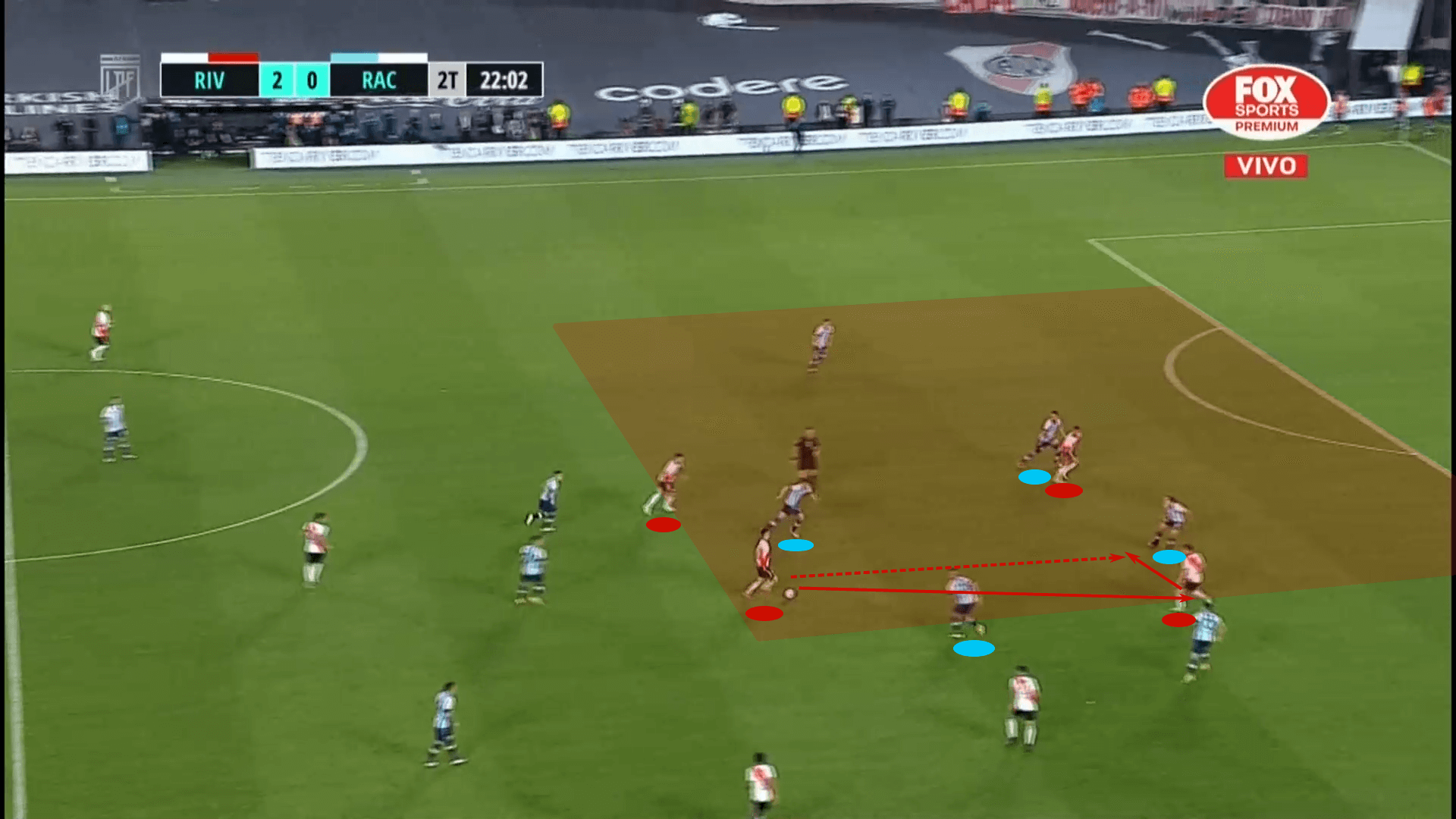
Agustín Palavecino’s run from a deeper area allowed him to pin the first line of defenders, then run behind them, creating a 3v2 going to goal. He slipped in Braian Romero for the simple finish from about the penalty spot.
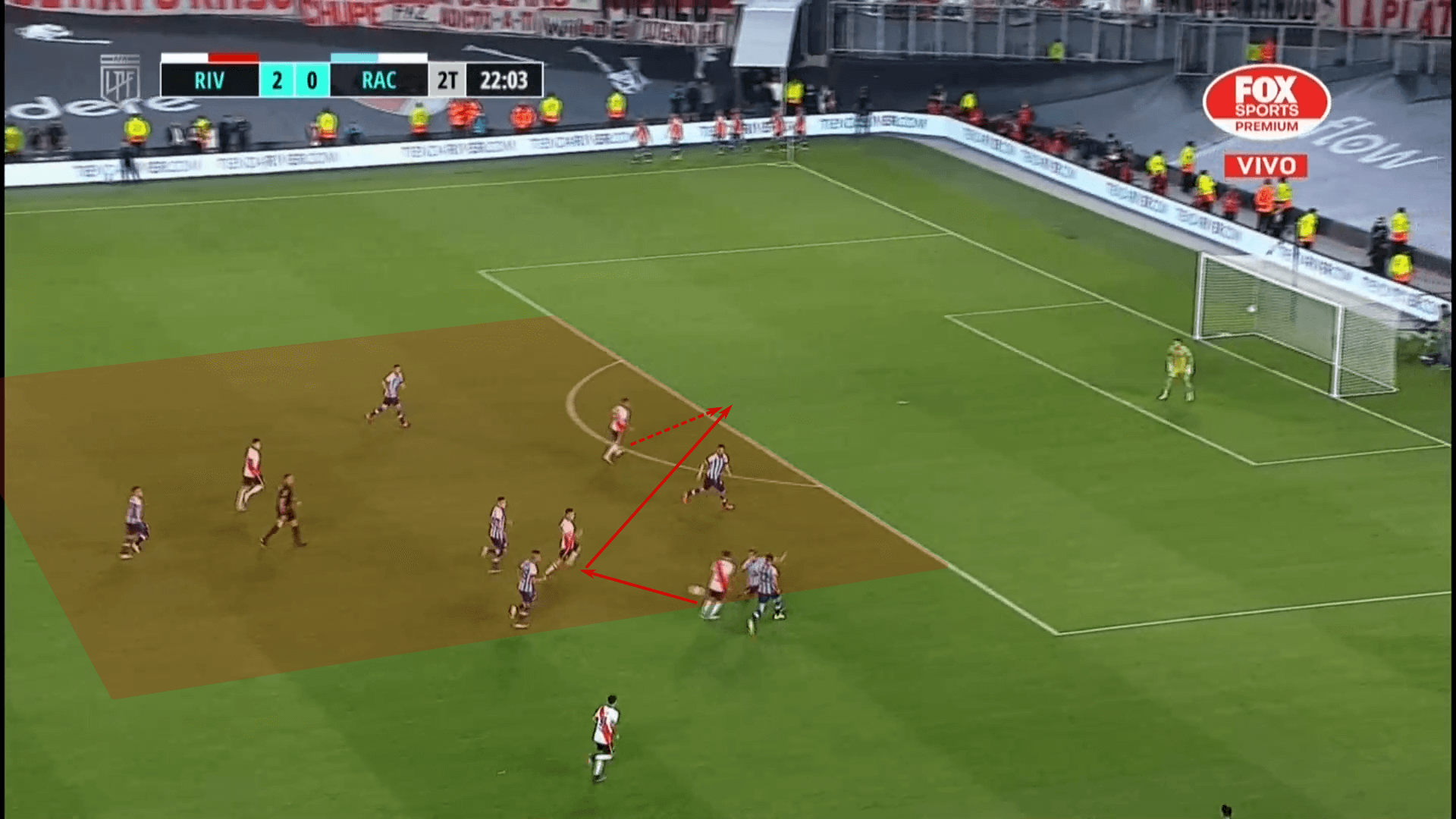
When Gallardo’s team plays the ball into a favourable numeric or positional superiority, they relentlessly attack it. Even in this example, the sequence starts as a 4v4, but the intelligence of the movements and timing of the passes takes an already favourable situation and improves upon it.
Gallardo’s River Plate was an explosive team in 2021. Expect much of the same in 2022. It was not only the ideas themselves that were impressive but also the coordinated way in which the team constructed their attack and read the cues in front of them. There was a fluidity to the side that we have to credit to the teaching of Gallardo.
Intelligent, resourceful and incisive in their attacks, River Plate’s one to watch in 2021 thanks to the man at the helm.
Defensive tactics
As a possession-dominant side that likes to create ball near overloads, you can rightly assume that counterpressing is a significant part of Gallardo’s defensive tactics at River Plate. Just mentioned in the previous section, The 2-3-5 rest defence features three industrious midfielders who are intelligently positioned to deny the opposition counterattacks with a quick, aggressive counterpress.
Looking at PPDA stats for the 2021 season, River Plate led the Primera División with 6.62 passes per defensive action. That’s almost a full point better than the next best team Talleres Córdoba (7.51). Given the data we’ve already seen in this analysis, it should come as no surprise that River Plate led the league in both PPDA and PPDA against (12.12). Opponents tended to drop off, sitting a little bit deeper to absorb River Plate’s pressure. As La Banda progressed up the pitch, opponents had more space to counterattack into, increasing the importance of the River Plate counterpress.
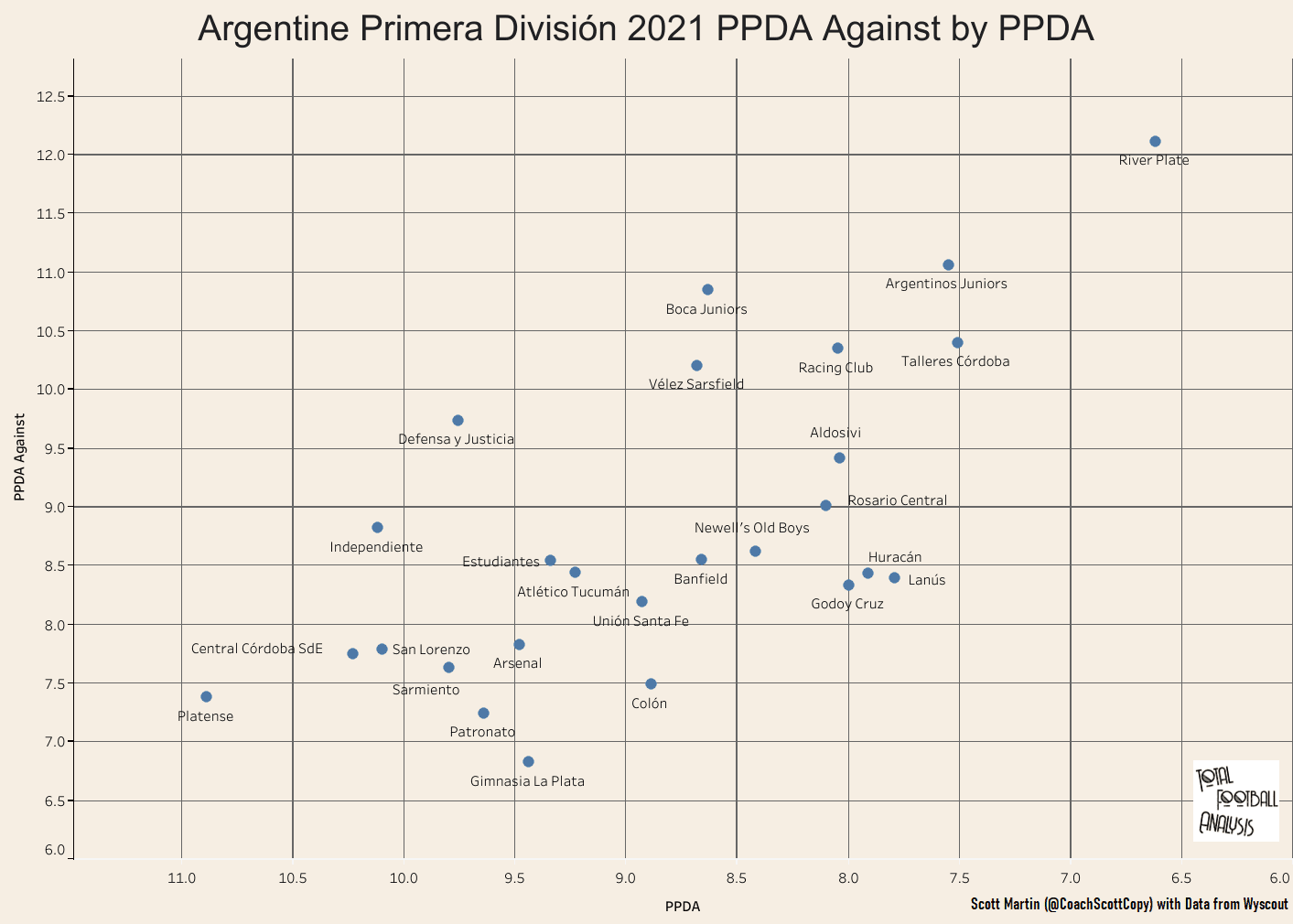
So let’s jump into that counterpress.
Perhaps the greatest influences in River Plate’s successful counterpressing were their central and ball-near overloads. Once they lost the ball, they typically had numbers nearby who could immediately pressure the first attacker. With their 3-2 or 2-3 rest defence structure at the back and more tightly connected network up top, Gallardo ensured his players’ in-possession starting positions allow for a quick transition to defence.
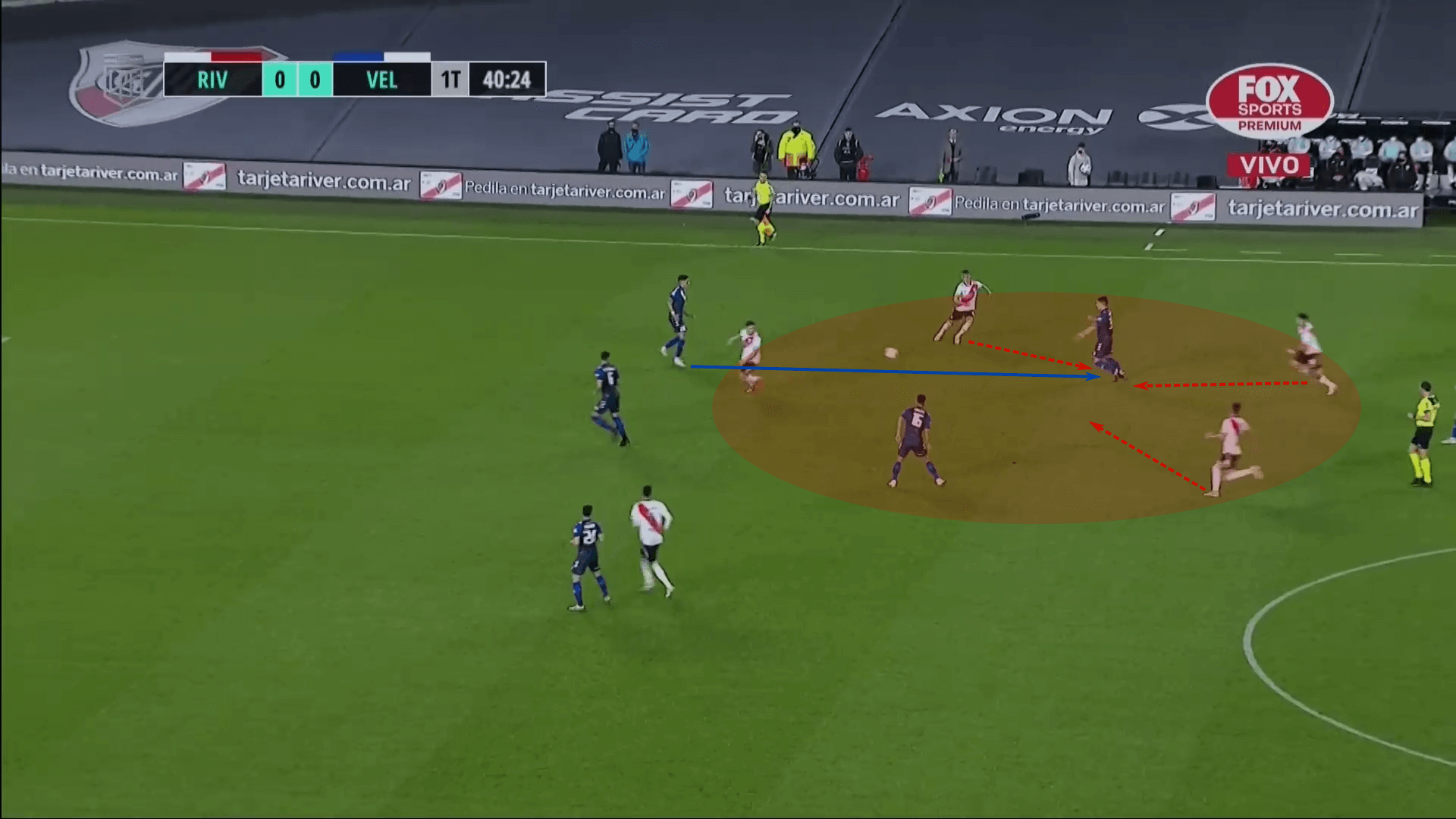
That’s exactly what we see in the match against Vélez Sarsfield. Immediately after losing the ball and seeing the first pass played into midfield, River Plate has four players near the ball, three of whom are ready to pressure while the highest player takes away two negative passing options. When the opponent tries to spin out of pressure, River Plate wins their 2v1 and transitions back to the attack.
When defending against open attacks, Gallardo will set his team out in a high press. One of the most common themes witnessed was that he asked his four highest players to be ready to pressure either of two options. As you can see in this second image from the Vélez Sarsfield match, the players first position themselves to take away the middle, funnelling play into the wings. But when you look at their positioning relative to the opposition, the first priorities are to take away the two central midfielders while also positioning the midfielders and forwards to coordinate first defender pressure on the outside-backs should one of them get the ball.
In this instance, the ball is played to Tomás Guidara in the right-wing. Had the ball been played behind him, Julián Álvarez would have dropped from his high position to pressure. Since the ball was played higher in this instance, Agustín Palavecino was responsible for the first defender role. He released his central mark and sprinted into the wing, forcing a bad touch from Guidara and earning the recovery.
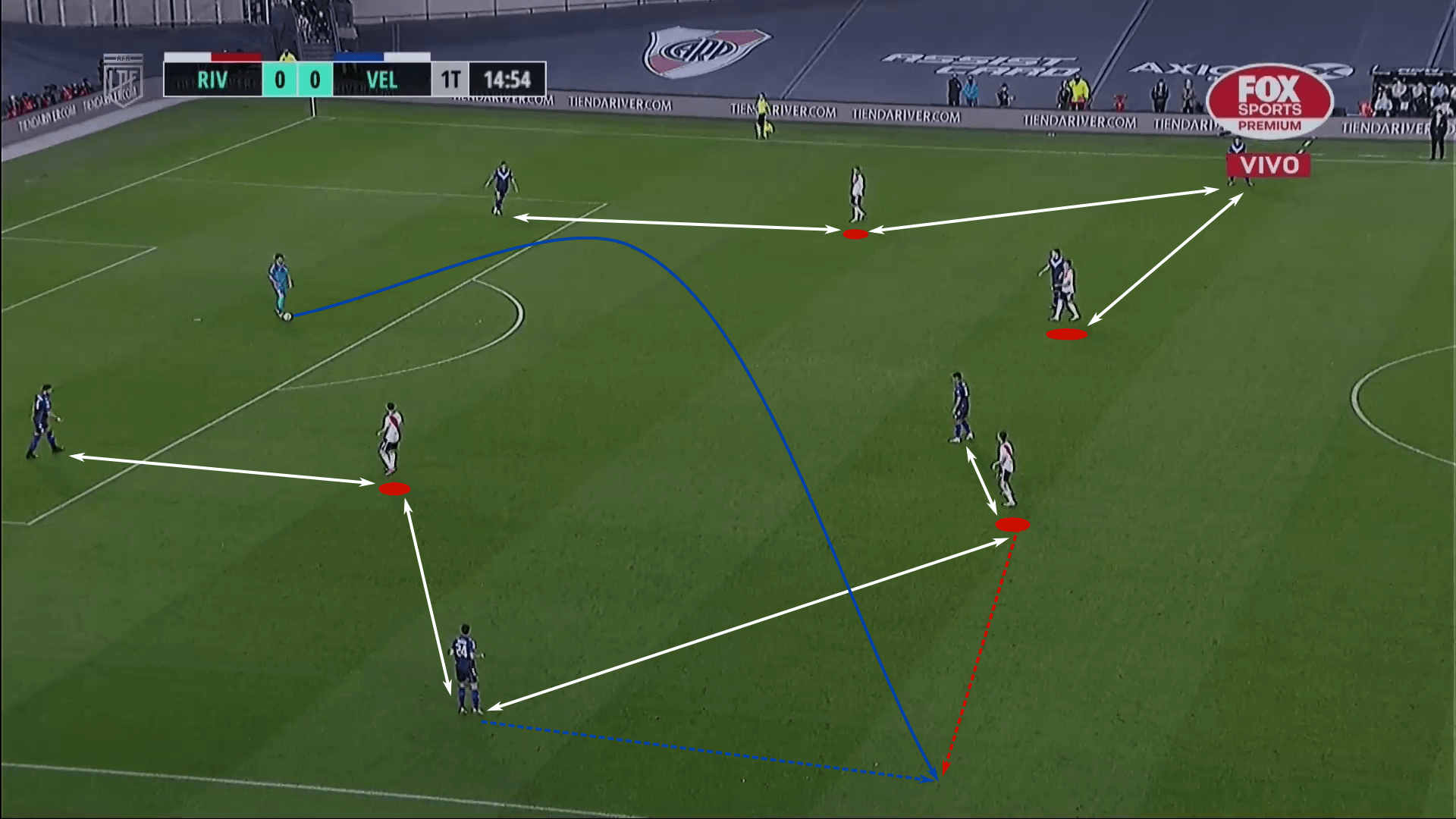
But what would have happened if Guidara had retained possession of the ball?
We get a better sense of River Plate’s intentions from the Racing Club match. Once the ball is funnelled into the wings, which is an objective of Gallardo’s high press, River Plate condenses the width of the pitch. Since the four highest players were asked to cover six players in our first high press image, you can get the sense of how the two far-sided players are left to themselves as River Plate push numbers near the ball. If executed well, there’s a man-to-man look to it. We can see that in the Racing Club example. Once play is funnelled left, River Plate creates a 5v5 on that side of the pitch. That immediate pressure on the ball carrier leads to a turnover and River Plate counterattack.
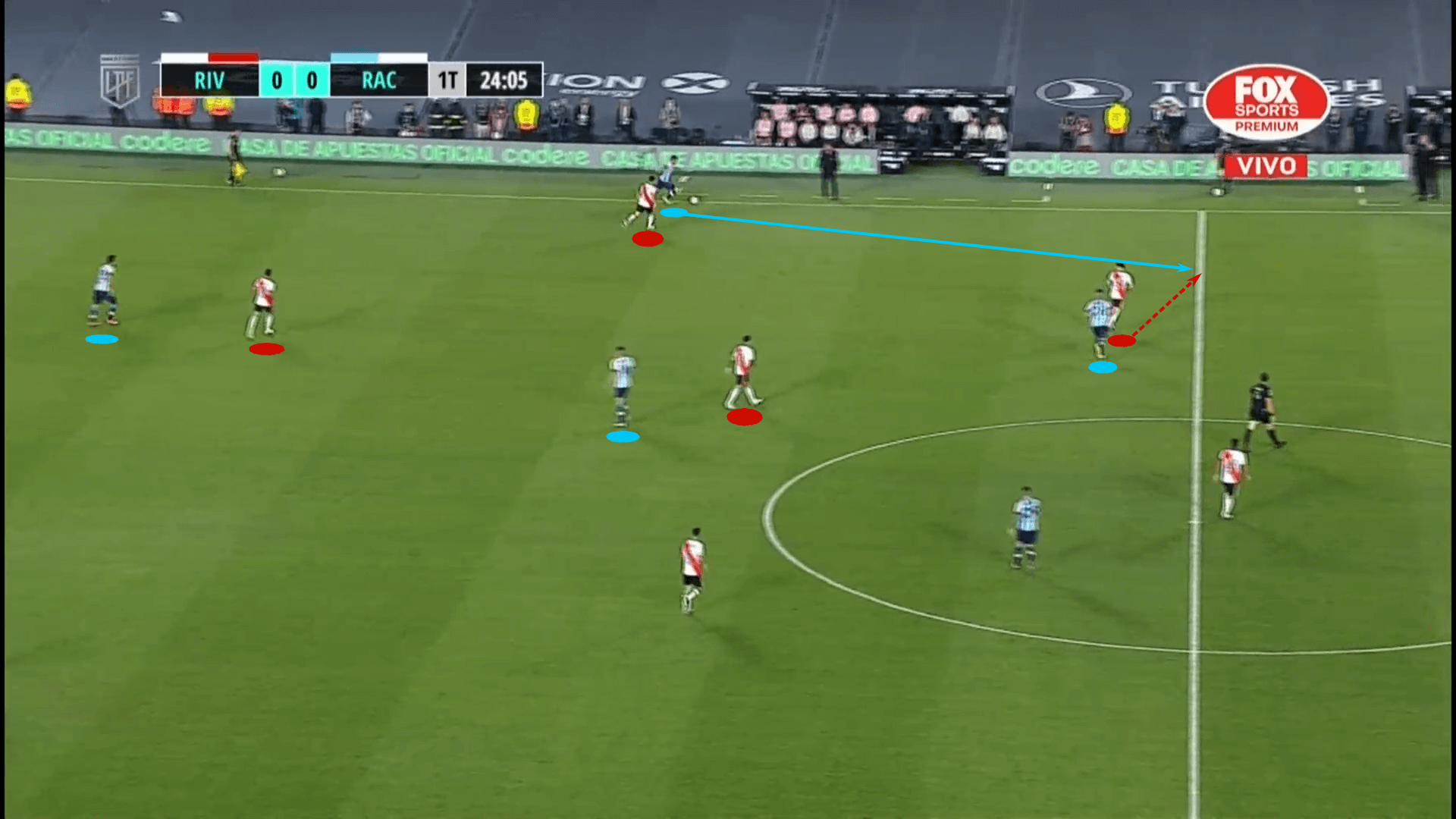
If there was one area where River Plate’s defence tended to struggle, it was in allowing opponents to access the space behind their outside-backs. In some cases, they were simply caught too high up the pitch and unable to cover that ground. However, there were far too many cases where the team just seemed unsure of how to conduct the press in the wings, especially as the opposition executed a dynamic positional rotation, such as the left forward moving into the half-space to switch roles with the #8.
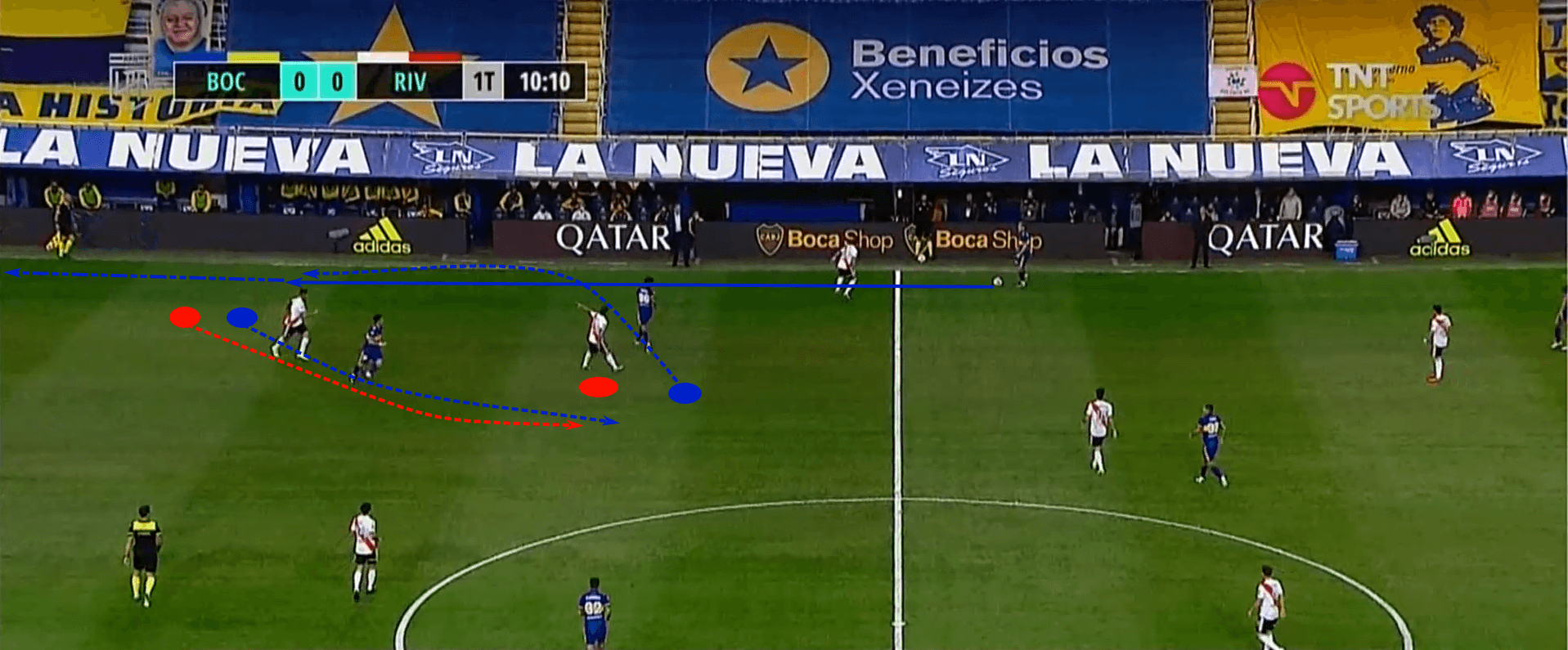
As we can see in this final example of the article, River Plate fails to pass along their marks as the dynamic positional rotation is carried out. Instead, both the left-back and left centre mid get caught in the left half-space, freeing up the wing for the opposition to attack. An excellent first touch allowed Cristian Medina to turn the corner and run at the centrebacks. The result was fewer numbers to defend against the cross and more space for the opposition to attack.
Boca Juniors scored a highly controversial goal through Carlos Tevez, who cleaned out Martinez before latching onto the cross. Despite the controversy, it’s a defensive breakdown higher up the pitch that leads to the goal. A simple switch would have preserved the zonal marking structure, eliminating the option for easy wing progression.
But even on the defensive side, this is not a team with many tactical flaws. Excellent structure in possession and an aggressive counterpress do the majority of the work. When Gallardo’s side defends in open play, their structure and ability to keep the field compact, funnelling play into pressing traps, which led to an exceptional season.
Conclusion
Many speculated that River Plate’s league championship was a perfect send-off for Gallardo as he moved on to ply his trade with the top club in Europe. Fortunately for River Plate fans, and much to the chagrin of the rest of the league, Gallardo has signed a one-year contract extension will be with his beloved club in 2022.
The short-term future is secure, but Gallardo’s long-term path is still unknown. He has said that he will remain at River Plate as long as they’ll have him, but with each successful campaign, there’s mounting speculation that he will move on to a new challenge in Europe. Xavi’s return to Barcelona ends speculation of Gallardo’s move to the faltering La Liga giants, but speculation of his move to Spain is a sign of his coaching pedigree.
Whether Gallardo remains in Argentina for the foreseeable future or is lured to Europe by a top club, expect rumours to continue swirling around his next destination. His tenure at River Plate has shown his quality, why he is one of the most exciting young coaches in the game and why he is Pep approved.

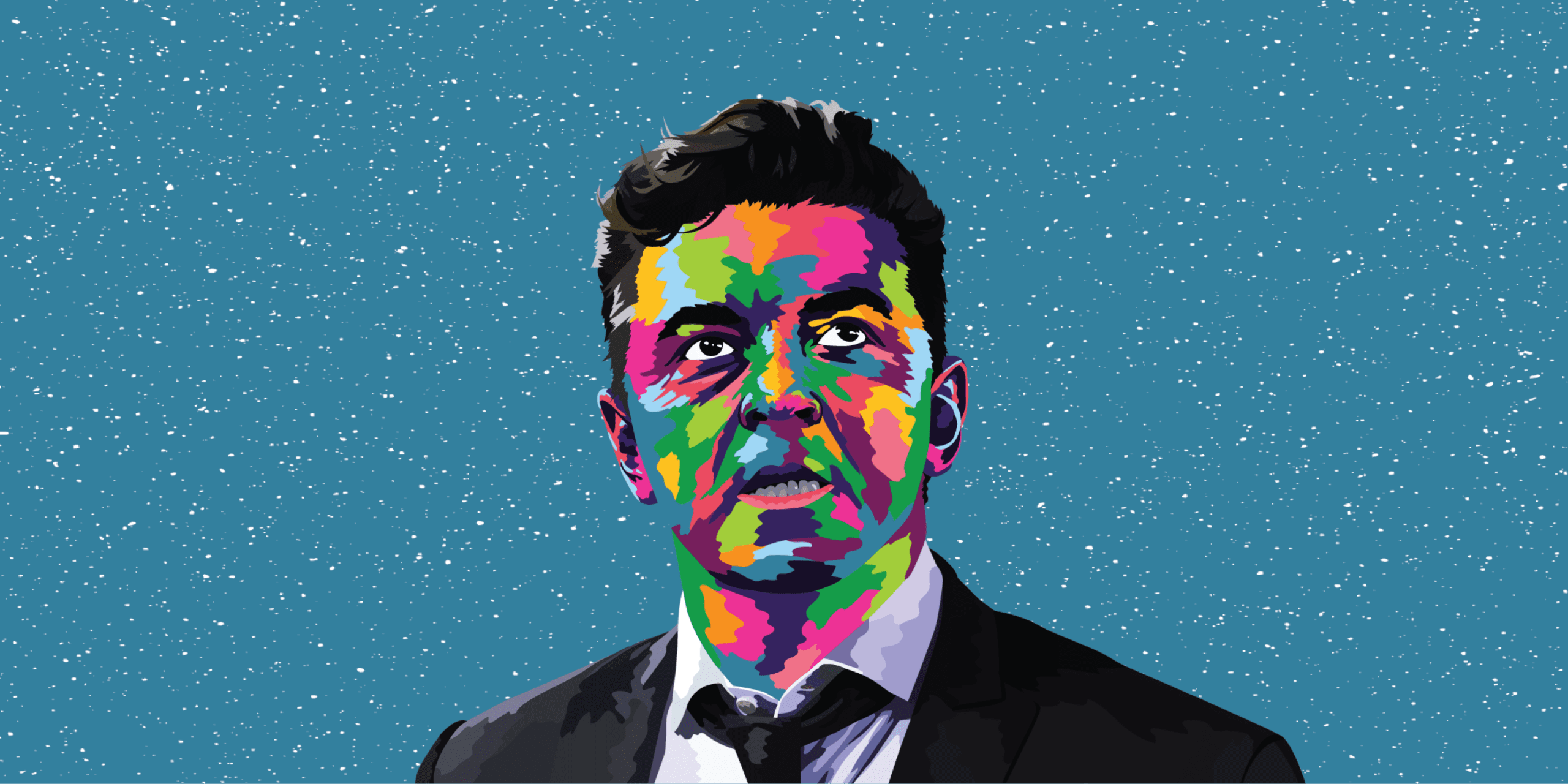



Comments